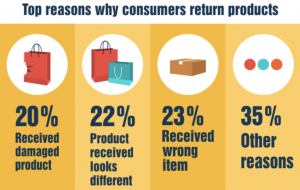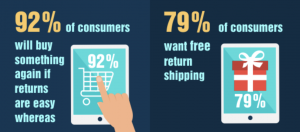Returns are one of the main challenges that retailers face. If the goods bought offline are returned only by 8.89% of consumers, then an indicator of eCommerce purchases reaches at least 30%. A return merchandise authorization (RMA) covers the process of returning goods to receive a refund, replacement, or repair. The strategic eCommerce partner knows how to optimize RMA and ensure the best customer experience of returnings the process.
Returns are a real headache for retailers. Why? Because such operations entail financial costs in terms of staff and resources, as well as the risks that not all products may be resold. According to Gartner Research, only half of them will be sold at full cost, the rest will entail money losses. The total amount of return of goods by the Americans amounted to $309 billion in 2019. So, retailers’ goal is to decrease this indicator as low as possible.
Your reliable e-commerce solution partner always knows how to provide exceptional customer service and make them satisfied. Let’s take a look at how return policies in e-commerce work, what exactly customers return and why, and also what retailers should improve.
The main reasons why customers return purchased goods:
 20% – received damaged product
22% – product received looks different
23% – received the wrong item
35% – other reasons
20% – received damaged product
22% – product received looks different
23% – received the wrong item
35% – other reasons
Referring to the first issue – “receiving damaged product” – we can recommend paying attention to such improvements:
- If you have your own delivery service, make sure that you provide exceptional service. Accuracy and courtesy of couriers are in the first place.
- If you are partnering with a third-party delivery service, then pay special attention to the choice of a contractor. It should share your values and mission. The interface of the online store and the behavior of the courier is the main points of contact with the customer. There is no place for errors.
Referring to the second problem – “products received look different” – we are sure that the basic value of each online store is a product card. We’ve told about the importance of quality product card in the previous article. Your professional eCommerce solution partner will exactly advise you to ensure the high quality of such things:
- products on photos and videos should look as similar as possible to what they are in real life. The product card must sell. So, photos should be of the highest possible quality, displaying colors, sizes, shapes. If possible, product cards should contain video reviews or 3D models.
- the retailer should provide the buyer with clear and well-presented information about the product, methods of payment, delivery, as well as the return policy. 67% of shoppers check the returns page before making a purchase. The more information you provide initially, the less likely there will be misunderstandings in the future.
- you should use customer reviews for providing additional information. This social proof also confirms the quality of the product. It causes trust to the brand and confidence that the purchase will be successful.
Regardless of what caused the return of goods, it is important to remember that 92% of consumers will buy something again if returns are easy whereas. As a loyalty oriented company, you must arrange return conditions that meet the principle of “providing exceptional service”.

A striking example of a company that has made a return policy one of the key elements of the customer journey is Zappos. The store offers free 365 day returns. According to Zappos conditions, if you are not 100% satisfied with your purchase from Zappos, you can return your qualifying item(s) for a full refund. Shipping from anywhere in the United States is always free. Considering that 79% of consumers want free return shipping, the Zappos company provides a world best practice case.
Also, 23% of customers noticed that they received the wrong items and forced to connect merchants for returns. The least that retailers can do – to specify “received the wrong item” reason in Return Policies and provide free delivery. For increasing loyalty, you can give gifts, new samples, or provide a discount for the next purchase.
Even though returning a product is more of a negative experience for retailers, they can get a positive impact from it. The main thing to remember is that the point-of-return is a real customer service “moment of truth”. Using return merchandise authorization you will provide the best service. With the support of your strategic solution partner, you will have the opportunity even to cross-sell or up-sell during the return process.